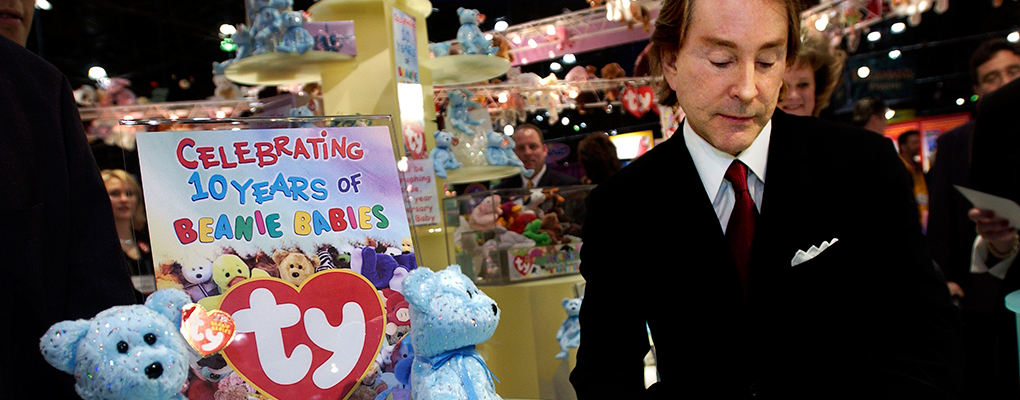
Stuffed-toy assets
In 1993 Ty Warner began to sell stuffed-animal toys, known as Beanie Babies. Due to the self-imposed scarcity of the product by the manufacturer – a result of Ty Warner never wanting to see his product in discount bargain bins – in the mid 90s the toys were considered collectables. Customers began reselling Beanie Babies for high prices to other speculators who imagined, as with all bubbles, the resale price would keep climbing. One such speculator purchased 20,000 of the stuffed animals for $100,000 dollars. After the bubble burst in 1999, prices never recovered. The toys now go for only a few dollars on eBay. According to Zac Bissonnette, author of The Great Beanie Baby Bubble: Mass Delusion and the Dark Side of Cute, “It was something really adorable that brought out the worst in people,” with one man serving a prison sentence in West Virginia for a murder stemming from a Beanie Baby sale gone-wrong. In an age of stock market rallies and economic optimism, people imagined everything, even stuffed animals, had high investment-potential.
Too many dollars, not enough nickel
The Poseidon bubble of 1969-1970 was also a product of its time. The Vietnam War had created a soaring demand for nickel, while industrial unrest had restricted its supply. When the Australian mining company Poseidon NL purportedly found a promising site for nickel mining in Western Australia, speculation on future profits was rife. As a result the price of Poseidon’s shares soared from $0.50 to $35. As Poseidon stock became too expensive for some investors, they began to snatch up shares in mining companies in nearby locations, often with no prospect of mining nickel. Other companies began to list to attract money from the investment frenzy, often with no intention or realistic prospect of ever mining nickel. Once it became apparent in 1970 that a lot of this stock was worthless, the bubble burst. Poseidon suffered further. When it began to mine the nickel that had started the boom, the quality was not of the grade first thought, resulting in higher extraction costs making the operation unprofitable.
The original Ponzi
Many speculative bubbles are often seen as skirting the line between frenzy and fraud. Ponzi-scheme bubbles – where the seller pays new investors with the money of old investors – sit firmly in the latter category. The originator of the Ponzi scheme was an Italian migrant to America in the early 20th century named Charles Ponzi. In 1919, his scheme was originally to purchase international postage stamps from countries where they were cheaper, exchange them for the American versions and resell at the higher American price. Operating this scheme in Boston in an age of European migration, such international postage stamps were a common feature of everyday life. The fluctuation of exchange rates and variation in international stamp prices allowed for profit to be made. Yet Ponzi went further, promising unrealistic returns to clients who would offer large investments, which Ponzi then paid back to older clients. Money poured in as people began to hear about this alleged Italian financial genius, and Ponzi’s celebrity and charisma was able to keep the charade going for a while. Saner heads soon started to question the ability to make such large profits through the sale of postal stamps, considering that much more stamps would need to be in circulation than actually were to justify the large profits Ponzi was claiming to be able to make. As the world’s first Ponzi scheme collapsed, authorities caught up with the conman, and gave him a hefty prison sentence.
Brazil’s failed industrial policy
The late 19th century was an era of industrial catch-up. From Germany, to the United States to Japan, previously agricultural nations were rapidly moving closer to the established industrial power of Great Britain. Seeing this advance, the government of Brazil was influenced to foster its own domestic industry in the late 1880s. The Brazilian state hoped to achieve this through unrestricted credit for industrial investment, increasing the money supply. The access to easy money did little to structurally transform the Brazilian economy, but rather created a financial and real estate boom. The bubble burst in the early 1890s and saw the foreign exchange value of Brazil’s currency collapse to a third of its former price.
Higher education bubble
According to some, we are in the midst of an expanding bubble right now. Higher education is one of the main political and economic concerns of our time. With rising tuition fees in much of the developed world, and increasing access to and demand for higher education in the developing world, a university degree is now often seen as a personal investment. And with all investments, there is an expectation of some sort of return. According to PayPal co-founder Peter Thiel, the higher education expansion is a bubble, primed to pop. Thiel’s argument was summarized in Tech Crunch as such: “Like the housing bubble, the education bubble is about security and insurance against the future. Both whisper a seductive promise into the ears of worried Americans: Do this and you will be safe. The excesses of both were always excused by a core national belief that no matter what happens in the world, these were the best investments you could make. Housing prices would always go up, and you will always make more money if you are college educated.” With Americans forking out large sums of money for a university degree, the bubble will supposedly burst once it becomes apparent that the investment has not accrued the benefits promised upon purchase.


